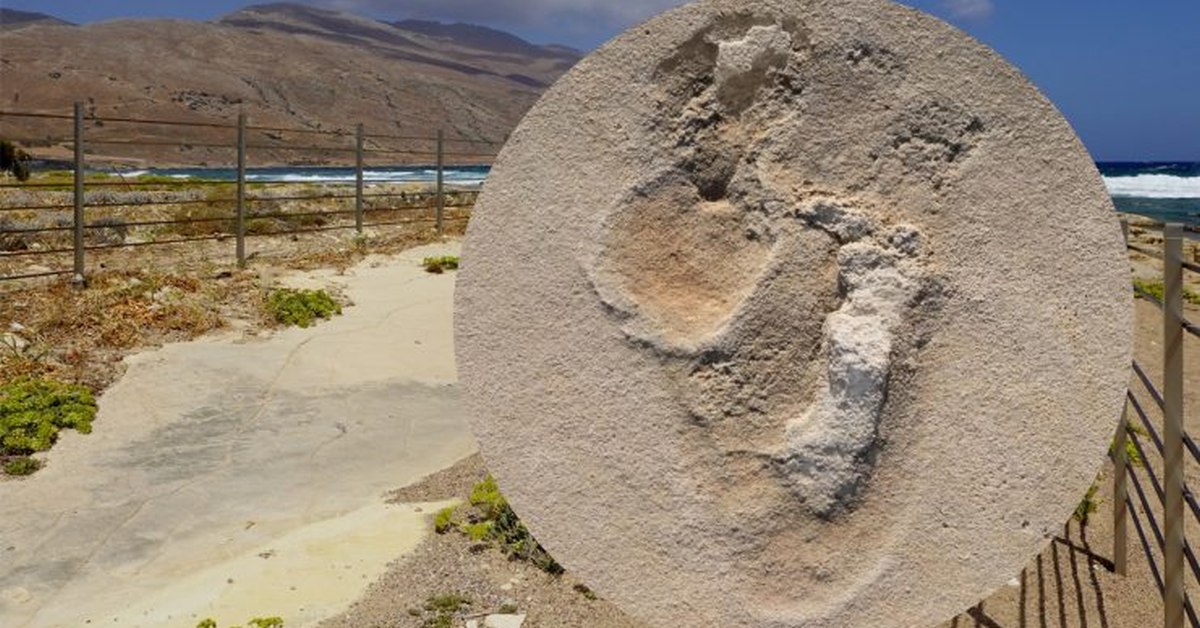The oldest known pre-human footprints, discovered on the island of Crete in 2002, have been dated as being 6.05 million years old, about 350,000 years older than originally estimated.

A new study by researchers at the University of Tübingen in Germany has pushed back the estimated age of 50 footprints preserved in rock slabs on the Mediterranean island of Crete – footprints that were already thought to be among the oldest pre-human prints in the world when in 2017 they were first dated to the Miocene, some 5.7 million years ago, Cosmos reports.
This time, the researchers used geophysical and micropaleontological techniques to reveal that the footprints are around 350,000 years older than originally thought. This makes them the oldest direct evidence of a human-like foot used for walking – something that challenges the prevailing wisdom about human evolution.
The footprints were discovered in 2002 near the small Mediterranean town of Trachilos by researcher Gerard Gierliński from the Polish Geological Institute, Warsaw. Unaccompanied by evidence of forelimbs pressed into the earth, Gierliński reckoned the prints belonged to a bipedal ape – someone who didn’t walk on all fours.

When Gierliński returned to date the fossils more than a decade later, he calculated the rock slab would have been solidified around 5.6 million years ago, and estimated that the tracks were laid down around 100,000 years before.
Now, even that time span would make them some 2.5 million years older than the tracks of Australopithecus afarensis, otherwise known as Lucy, who is widely regarded as humanity’s most ancient ancestor. Given they are really from pre-humans, the footprints would mean a massive departure from the “Out of Africa” theory, which says humans first evolved in Africa.

Sure enough, when Gierliński presented the findings in public, rebuttals were swift, with other scientists likening the footprints to those of gorillas rather than something resembling human. But with the help of 3D printing and laser-scanning the prints, Gierliński and his research team identified key features that appeared to be similar to ours, including a ball region, a pulling-up motion of lifting the foot, and evidence of a hallux or big toe.
Gierliński and his team reckoned these mysterious ancients could have been the ancestors of modern hominins, representing a step in the chain to the modern bipedal ape.
According to Madelaine Böhme of the University of Tübingen in Germany and co-author of the new study, “we cannot rule out” the possibility that the tracks could be linked to Graecopithecus freybergi, a previously unknown pre-human species that the team previously uncovered in Athens, and which lived in Europe 7.2 million years ago, just 250 kilometres from the Cretan prints.

Böhme and the rest of the team believe that evidence for the short-term expansion of the Sahara Desert some 6 million years ago could explain the separate but concurrent evolution of bipedalism in the mysterious Cretan hominin.
According to the “Desert Swing” theory, about 6.25 million years ago aridification in Mesopotamia would have forced many mammals, including primates, out of Eurasia and into Africa, while an expansion of the Sahara 6 million years ago would have sealed off the two continents, separating our ancestors from each other and sending them on distinct – but potentially similar – evolutionary paths.
Recognizing a pre-human footprint in Europe would throw the prevailing wisdom about hominin evolution out the window. So far, Africa was believed to be the cradle of humanity, because the earliest known hominin fossils – as well as some of the oldest stone tools ever found – are almost invariably from there. But this discovery challenges it all.
Sources: 1, 2
